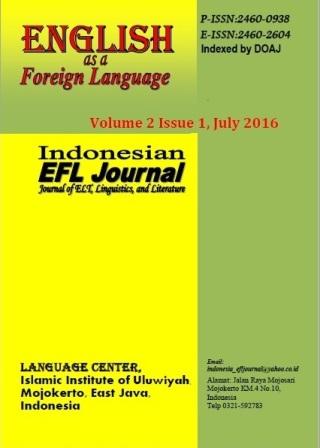Students’ Learning Styles: An Ethnographic Case Study at UIN Walisongo Semarang
Abstract
This research is aimed to know what kinds of learning preferences are students intended most? And how many types of learners’ characteristics appear in ELT classrooms? This research was conducted through qualitative approach. This means that the data are collected not in the form of numbers, the data are taken from questionnaires, documentation, and observation. The results of this study are as follows: students of ELT program at UIN Walisongo Semarang tend to study by various kind of learning. It can be proved that First, regarding to the description of 2A class which has 11.2% visual students, 16.02% of audio-lingual, 5% kinaesthetic and 14.11% are others, would use multimedia which is available in the classroom. Whereas, the description of 2B class has shown that 13% students are visual learners, 11% audio-lingual learners, 6.72% kinaesthetic and 13,72% are others. Last but not least, there are 12% visual learners, 11.17% audio-lingual, 7.25 kinaesthetic and the rest 14% others. Furthermore, there are four characteristics which appear from the research, they are as follows: visual learners, auditory learners, kinaesthetic learners, and other characteristics.
References
Brown, D.H. (2000). Principles of Language Learning and Teaching. Pearson PTR Interactive.
Chatib, M. (2012). Sekolahnya Manusia. Yogyakarta: Pustaka Pelajar.
Dimyati, & Mudjiono .(2006). Belajar dan Pembelajaran. Jakarta: PT. Rineka Cipta.
Djamarah, S.B. (2000). Guru dan Anak Didik dalam Interaksi Edukatif. Jakarta Rieneka Putra.
Elliot, S.N. (2000). Educational Psychology, Amerika: Von Hoffman Press.
Gardner, H. (1983). Frames of mind: The theory of multiple intelligences. New York: Basic Books.
Gardner, H. (1998). A multiplicity of intelligences. Scientific American Presents: Exploring Intelligence, 9(4):19-23.
Gardner, H. (1999). Intelligence reframed: Multiple intelligences for the 21st century. New York: Basic Books.
Gardner, H. (2006). Multiple intelligences: New horizons. New York: Basic Books.
Key learning community. (2007). Retrieved April 16, 2008, fromhttp://www.616.ips.k12.in.us.
Hamalik, O. (2007). Dasar-dasar Pokok Pendidikan. Bandung: PT Erisco
Kartini, K. (1989). Pengantar Metodologi Research Social, Bandung : Aluni,.
Keirl & Moleong, L. (2004). Desain Penelitian. Lumbung Pustaka UNY
Manser, E. (1995). Structures for Emotional Intelligence. Kagan Online Magazine
Moleong, L, (1991) Metode Penelitian Kualitatif .Bandung: Remaja Rosda Karya,
Mulyasa. (2010). Metodologi Penelitian Kualitatif. Yogyakarta: Pustaka Pelajar.
Nazir. (2003). Metode Penelitian. Jakarta: PT. Ghalia Indonesia.
Nunan, D. (1992). Research Methods in Language Learning. Cambridge: Cambridge University Press
Sagala, H. l. (2006). Konsep dan makna pembelajaran : untuk membantu memecahkan problematika belajar dan mengajar. Bandung: CV Rineka.
Copyright (c) 2016 Indonesian EFL Journal: Journal of ELT, Lingusitics, and Literature

This work is licensed under a Creative Commons Attribution-ShareAlike 4.0 International License.
All rights reserved.
this publication may be reproduced, stored in a retrieval system, or transmitted
in any form or by any means, electronic, mechanical, photocopying, recording.




